IDEX Online Research: Jewelry Price Inflation Diminishes
April 28, 09
Inflation in the jewelry industry continues to diminish, both at the supplier level and the consumer level. This is no surprise, for two reasons:
- There is weak demand at all levels of the distribution pipeline. When demand is weak, prices tend to stabilize or fall, rather than rising.
- No single supplier or retailer has pricing power. The industry is highly fragmented at both of these links in the distribution chain.
While the jewelry industry deals with weaker pricing, economists around the world are worried about inflationary trends, especially over the long term. All of the government stimuli that have been thrown at the current recession will likely create inflation – perhaps flaming inflation – when the economy eventually recovers.
If inflation is coming, according to the economists (remember, though, they are the same people who didn’t see the current recession coming), what does this mean for the jewelry industry? As commodity prices rise – and they surely will – materials costs will increase. Wage and salary costs are also expected to rise, as workers demand more money to pay for increasingly expensive goods and services. It is clear that price inflation is in store for the jewelry industry, but probably not until late this year or beyond.
Our reaction: enjoy this momentary lull. It appears that the industry has reached a balance or equilibrium between deflation and inflation trends. We are no longer facing the prospects of deflationary pricing. But we are likely to face inflation, perhaps by 2010. Thus, we’d begin to add goods to our inventory while prices are still low.
Jewelry Price Inflation: March 2009
Here’s the summary of inflation at the jewelry retail and supplier level for the month of March 2009, as expressed as a percentage change year-over-year (March 2009 versus March 2008) in the U.S. market:
- Jewelry Producer Price Index +1.0 percent
- Precious Metals for Jewelry 0.0 percent (flat)
- Jewelry & Watch Consumer Price Index +3.1 percent
- Jewelry CPI +3.1 percent
- Watch CPI +3.2 percent
At the retail level, inflation has continued to moderate, as predicted, primarily because we are nearing the anniversary date of last year’s price increases that jewelers implemented in the second quarter. Comparisons in the first few months of 2009 versus the same period in 2008 reflect “old pricing” in 2008 versus “new higher prices” in 2009. In subsequent months in 2009, retail prices will be compared to the higher prices which were implemented in the second quarter of 2008. Since there have been no material retail price increases since mid-2008, inflation at the retail level in the U.S. market should remain modest. Even when demand recovers, we don’t look for any significant retail price increases until perhaps 2010. Merchants are going to be cautious before they implement new higher prices which might scare off their loyal customers.
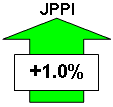 |
Jewelry Producer Price Index (JPPI) +1.0 percent in March
The following graph summarizes the monthly Jewelry Producer Price Index for inflation since early 2007. The percentage figures are based on year-to-year comparisons of the BLS Jewelry Producer Price Index (March 2009 versus March 2008).
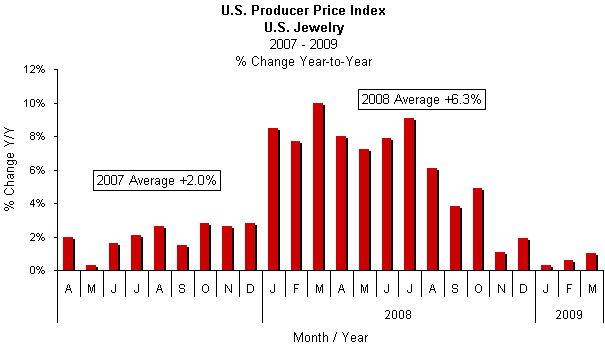
Source: BLS
Jewelry prices at the supplier level – as measured by the Jewelry Producer Price Index – have held relatively steady for a multiplicity of reasons, including the following:
- Retail jewelers have cut back on re-ordering merchandise. Thus, with no solid demand, suppliers have no pricing power.
- There is still a large backlog of high-cost goods in the distribution pipeline that suppliers need to pass on to their customers.
- Retail jewelers simply won’t accept higher prices in the current recessionary environment.
Prices for both precious metal jewelry and gemstone jewelry have moderated. The graph below compares the JPPI (red bars) to inflation for precious metals (gold bars); gold had been the primary driver of precious metals inflation in 2007 and most of 2008. In January 2009, gold prices pulled back modestly, but have risen – and held steady at about $900 per ounce in February and March. In our opinion, $900 gold has been priced into goods produced by jewelry manufacturers, and therefore producer prices aren’t likely to rise notably from current levels.
As the graph below illustrates, precious metals jewelry prices at the supplier level showed deflation in January and February, but leveled off in March. The JPPI for Precious Metals in March was flat (thus, there is no gold bar showing on the graph).
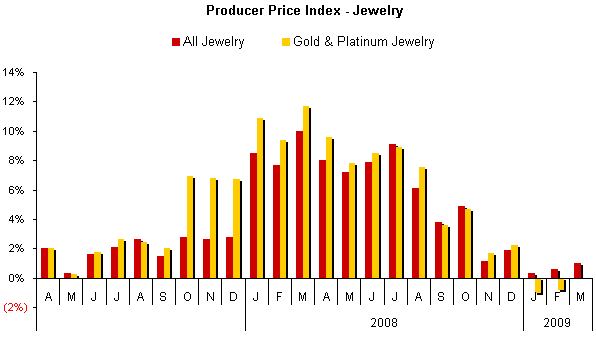
Source: BLS
We note, further, that the Jewelry Producer Price Inflation Index in March – +1.0 percent – was significantly below the Jewelry Consumer Price Inflation Index of +3.1 percent for March. These trends illustrate the lag effect between rising producer prices and the resultant rising retail prices.
Jewelry Consumer Price Index (JCPI) +3.1 percent in March 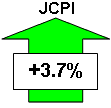
U.S. jewelry consumer prices (JCPI) rose by 3.1 percent in March 2009, as calculated by the BLS. After rising sharply through the second quarter of last year, jewelry price increases at the retail level moderated in the late summer of 2008, a trend which continues due primarily to the current recessionary environment.
For the full year 2008, retail price inflation for jewelry in the U.S. market ran at an annual rate of +6.9 percent. Now, however, it is clear that jewelry price inflation is moderating, and it will likely remain lower than 2008 in the coming months, especially as we reach the anniversary of last year’s price increases that jewelers implemented in the second quarter of 2008.
However, we note that jewelry price inflation at the retail level is still running well ahead of its two-decade annual gain of about +1.6 percent.
The graph below summarizes the percentage change in retail prices of jewelry and watches by month on a year-to-year basis since 2008. The percentage change is based on a comparison to the same month a year ago (March 2009 versus March 2008).
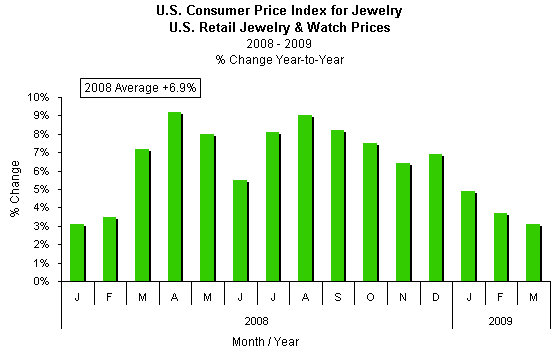
Source: BLS
Early in 2008, the components of jewelry and watch price inflation at the retail level reflected a disparity in price increases. Jewelry retail prices were up consistently during the first half of 2008, but watch retail prices showed virtually no price inflation. In the past few months, watch price inflation has steadily increased, though it moderated in January, picked up again in February, but softened in March. While there were several factors which contributed to inflationary pricing trends of watches – a shortage of watch mechanicals in Switzerland and strong demand at the very high end – these factors have largely dissipated due to weak demand at most all levels and price points of the watch distribution chain. We expect watch price inflation to track more closely to retail jewelry price inflation over the near term.
The graph below illustrates the JCPI consisting of both jewelry and watch prices (green bars), jewelry prices only (red bars), and watch prices (yellow bars).
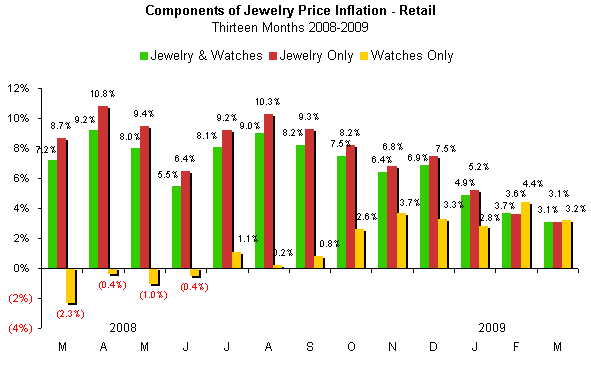
Source: BLS
Outlook: Modest Jewelry Price Inflation in 2009
After rising by nearly 7 percent in 2008, we continue to forecast more modest jewelry price inflation during 2009. The wild card, of course, is the price of commodities, including gold, silver, and platinum. If investors continue to buy these commodities as hedges against inflation, it will put upward pressure on jewelry prices. If the global economy recovers faster than the economists are predicting, prices of commodities could spike.
Our current prediction calls for 2009 price inflation to be in the low single digit level. This is a departure from our earlier forecast of modest deflation. The U.S. economy – which accounts for roughly half of all jewelry demand worldwide (by value) – is showing signs that the recession has bottomed. Thus, if consumer demand recovers, we won’t experience price deflation; instead, we could experience modest price inflation. Now, that’s a pleasant thought!